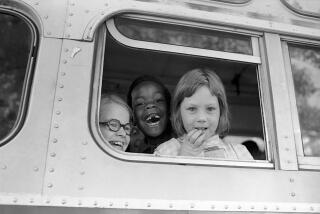Elements of Educational ‘Choice’
- Share via
The idea that parents and teachers should be directly and actively involved in children’s education is a solid, old-fashioned notion that has been revived this year as one of the hot topics of national discussion. Educational “choice,” giving parents the option of choosing which public schools their children will attend, is said to be the reason for leaps in reading scores and increased parent and teacher involvement in the once-languishing East Harlem school district. That district is regularly cited by the Bush Administration as the premier example of choice. But a close look at the East Harlem system, the only long-standing national example of choice, points out why it should not become the catch-all term to avoid the tough education-funding decisions that lawmakers and taxpayers must make.
The idea behind choice is that a free market system can work as well for schools as it does for private businesses; the good schools will attract more students and the ones that fall short will have to improve or perish. While the East Harlem students, teachers and parents do exude an infectious enthusiasm and pride in their now famous schools, Times writer Stanley Meisler found that it is not at all clear that instituting choice was the key factor in the improved test scores. Other factors, including the use of a different standardized test and an overall jump in scores throughout New York city, apparently played important roles.
The parents of East Harlem know themselves that good will and parental involvement in a school are not enough: They assailed Secretary of Education Lauro F. Cavazos during a recent visit there because the federal government rejected the district’s application for a $1.4-million magnet- school grant, leaving the local board to struggle to save 30 teaching and staff positions.
School-choice programs are being explored by some 20 states. Already in Richmond, Calif., Montclair, N.J., and the state of Minnesota, parents can choose another public school if they do not want their children to attend the neighborhood school. In Los Angeles, the magnet schools that focus on areas of interest and are designed to attract different ethnic groups citywide are a successful but limited example of choice.
The full-scale Minnesota program is being monitored to see how well the system works; there, as in an “open enrollment” program in Irvine, most parents so far have opted to keep their children in schools close to home. In East Harlem, even supporters of choice have been careful to point out its limitations. One of the early architects of the East Harlem system said that it worked there because it came gradually, one school at a time, and successful programs were kept small. That observation is a reminder that ideally a parent wants many excellent schools to chose from; but absent the ideal, it’s far better for a school district to offer a few excellent programs than lots of slapdash poor choices.
More to Read
Sign up for Essential California
The most important California stories and recommendations in your inbox every morning.
You may occasionally receive promotional content from the Los Angeles Times.










